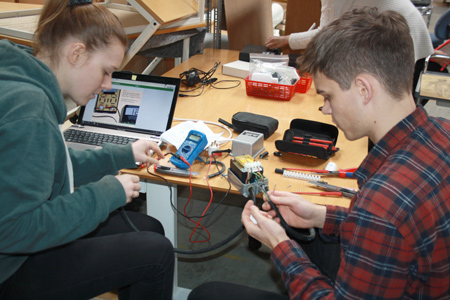Engineering World Health’s local department at DTU repairs medical equipment for developing countries.
When hospitals and businesses donate medical equipment to hospitals in developing countries, there is a risk that it does not function properly or that the recipients do not know how to use it. The worldwide organization Engineering World Health’s local branch at DTU is trying to remedy this. Rana Al-tayar, a sixth semester Medicine and Technology student, is among those responsible for ensuring that the equipment is in order before it is shipped.
“70 per cent of the donated medical equipment shipped to developing countries is not stable enough to be able to work over a longer period of time. It’s typically old equipment that has been stored in a warehouse for many years before it was donated,” she says.
When EWH sends students to developing countries to do relief work in the field, they sometimes get feedback that the equipment lies unused in large scrap heaps.
“Most often, it’s just a simple problem that can be solved very quickly. But when the equipment is donated, usually it does not come with user manuals or technicians and if so, it’s often in a language the recipients of the equipment don’t understand. They may not even know what kind of equipment it is, as it may be too high-tech compared to their normal standard.”
"It’s no good that you send equipment which can only be used for a period of five years. The idea is that the donated material is to help the country in the long term, and not only in the short term."
Rana Al-tayar, Medicine and Technology student at DTU

Photo: Rana Al-tayar
Equipment should be tested
The local EWH department at DTU is trying to communicate to the donors that they need to test and repair the equipment before sending it off.
“It’s no good that you send equipment which can only be used for a period of five years. The idea is that the donated material is to help the country in the long term, and not only in the short term. You need to find out whether it can be used, whether there’s a need for it, and whether it can last in the long term.”
In addition to spreading the message about the drawbacks of donations not properly thought through, the students at the EWH department at DTU repair the equipment themselves at repair workshops. For example, a team of students spent three whole days on testing, among other things, lamps, muscle stimulators, and patient beds at Haldor Topsøe,
Development of low-tech equipment
On the whole, EWH’s work is about making healthcare technology more accessible to help disadvantaged countries.
“We’re also developing less complicated low-tech equipment which does not impact the country financially. It must be simple to use, and it must be useable over a long period of time. Electrodes for ECG measurement—i. e. the heart rate—may in fact be replaced with soft drink caps, which is far less expensive and resource-intensive,” says Rana.
“The jelly which is used for ECG measurement can also be replaced with another material, as long as it contains electrolytes and is conductive. So, in principle, it can be anything that contains salt.”